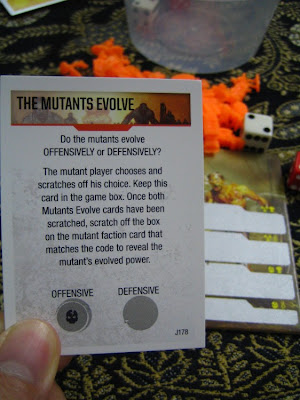Plays: 3Px1.
The Game
Ninjato is a worker placement game. Players are ninjas trying to win the most honour (i.e. victory points / VP) for their clans. A game consists of 7 rounds and every player has 3 actions per round. The worker placement mechanism here is non-blocking, i.e. if you have placed your shuriken (the "worker" in this game) at one location, others can still use that location. Most locations have a few items available, so getting there first means a better chance of getting the one you want.

Things you can do include gaining skill cards, learning special techniques, using these to rob or steal treasures, and then cashing in these treasures, i.e. gaining VP's, while also gaining envoy cards or rumour cards which are used during intermediate scoring and game-end scoring. The cashing in of treasures is to ensure they earn you their true worth. If not cashed in, they'll only be worth 1VP each at game end. The envoy and rumour cards are also important sources of VP's.
Envoy scoring, which is done 3 times, has a stock manipulation aspect to it. Each envoy card is from one of three noble clans. Players compete to collect the most envoys in each clan, for the intermediate scorings. Each if the 5 houses (where ninjas go treasure hunting) belong to one of the three noble clans and has an honour value which is scored during intermediate scoring. If in a round a house is completely depleted of treasures, the ninja who did it gets to change the house ownership and honour value. So you need to manage both gaining majority and manipulating the value of the majority.

The rumour card scoring is done at game-end only, and is based on matching rumour cards with other items collected. E.g. if you have collected many rumour cards for defeating elite guards, and you have also defeated many elite guards, you'll get good multipliers and score lots of points.
When attacking a house, you can choose to use strength or stealth. Strength means defeating guards by playing skill cards with bigger numbers, and stealth means the opposite. So big or small numbers do not mean good or bad. After defeating a guard, you can decide whether to press your attack to try to gain more treasures. However the next guard is randomly drawn so it's a gamble whether you have the right card to defeat him. If you defeat all guards, you not only get to claim all treasures, you also get to change the house ownership and honour value. However sometimes the number of treasures and guards can unexpectedly increase making it harder to clear out a house. Elite guards which are tougher to beat may also turn up. There's a push-your-luck element here. If at any time you decide to withdraw after winning a fight, you keep all treasures won thus far. If you attempt the next guard but lose you only get to escape with one treasure.

The Play
Allen, Han and I did a three-player game. I found that 3 actions per round really is not a lot. You need to plan ahead and make the most of every action. In our game I concentrated on green envoys, while both Allen and Han competed for red envoys. That was unfortunate for me, because while they competed for red envoys, they both had incentive to convert the houses to the red noble clan. Since they had no interest in the green noble clan, removing the green clan's control over houses became a default preference. That's baaad for me.
Attacking houses was fun. No matter how well prepared you are, there is no guaranteed success. Sometimes a house simply has too many hidden guards behind its walls and you don't have enough cards to beat them all. It's quite exciting.
Learning special techniques from the sensei can be a tough decision. A technique learnt early can be used many times, but sometimes it's tempting to grab those treasures and envoys early to get a good lead over your opponents. There is also jostling to manipulate turn order for the next round, which gives another aspect to fight over.


Allen scored many points from red envoys because the red noble clan controlled many houses and all were high valued. He had a huge lead by mid game and Han and I never managed to catch up.
The Thoughts
Ninjato is squarely a Euro design. It uses worker placement. It's a mid-weight game. There are a few different ways to score points and players can put different emphasis on how they want to score. The game is quite interactive, because you are always trying to grab good stuff before your opponents take them, and you keep manipulating the noble clan values to help yourself and hurt your opponents. I like the press-your-luck excitement in invading the houses to rob / steal treasures. You can plan, but there's always a little luck factor to keep things exciting.
I feel a little multiple-ways-of-scoring fatigue, because some of these multiple ways feel a little like they exist for the sake of balance and creating choices and not for thematic reasons. In particular the rumour scoring feels a little artificial. Treasure scoring and envoy scoring are much better integrated.
Buy from Noble Knight Games. Status: in stock (at time of this post).



























































